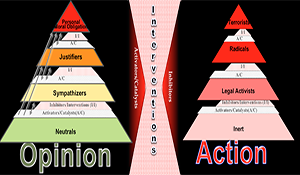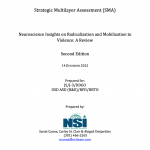Neuroscience Mobilization and Radicalization

Neuroscience Insights on Radicalization and Mobilization to Violence: A Review, Second Edition.
Author | Editor: Canna, S., St. Clair, C. & Desjardins, A. (NSI, Inc).
Radicalization is a complex phenomenon informed by various disciplines. The social sciences have provided planners and operators with an understanding of the ‘who’, ‘what’, and more recently the ‘how’ of radicalization. The neuroscience community is working to expand the understanding of ‘why.’ It is essential that planners and operators, who are often on the front line of counter-terrorism and counter-insurgency campaigns, have a deeper understanding of the why and how radicalization occurs. With a better understanding of the ‘why’ aspect of radicalization, planners, operators, and social scientists can move beyond purely correlative work. This report offers insights from these various fields in an easily accessible format for the operational and planning communities.
The Strategic Multi-layer Assessment (SMA) team—in partnership with federal organizations, industry, think tanks, and academia—has explored the concepts of radicalization and political extremism over the last several years, delving deep into analytic methods, subject matter expertise, and modeling experiments to assist military planners and operators in understanding and more effectively responding to the threat of radicalization. This review, intentionally concise, will summarize findings from previously edited volumes, conference proceedings, journal articles, and white papers produced by or for the SMA community exclusively. It is important to note this is not a comprehensive review of all open source material(s) on the topic, and as such, the reader should be aware the materials presented within were prepared specifically for SMA purposes and may not address all topics or issues within the field of study. This review presents theories, findings, and techniques from neuroscience, as well as insights from the operational community, to provide a current and comprehensive description of why individuals and groups engage in violent political behavior.
We reviewed approximately 3,000 pages of literature prepared for or by the SMA team. The full list of reviewed documents is available in Appendix A, but the core documents are listed below.
- Cyber on the Brain: The Effects of CyberNeurobiology CyberPsychology on Political Extremism (October 2012)
- Influencing Violent Extremist Organizations Pilot Effort: Focus on Al Qaeda in the Arabian Peninsula (Fall 2011)
- SMA 5th Annual Conference Proceedings 29-30 November 2011 Panel on Implications of Recent Advances in Social, Cognitive Neurobiological Science to National Security
- Countering Violent Extremism: Scientific Methods Strategies (September 2011)
- Neurobiology of Political Violence: New Tools, New Insights (December 2010)
- Defining a Strategic Campaign for Working with Partners to Counter and Delegitimize Violent Extremism (May 2010)
- Protecting the Homeland from International and Domestic Terrorism Threats: Current Multi-Disciplinary Perspectives on Root Causes, the Role of Ideology, and Programs for Counter-radicalization and Disengagement (January 2010)
- From the Mind to the Feet: Assessing the Perception-to-Intent-to-Action Dynamic (July 2009)
Background
Findings from the neuroscience community may often be challenging for the military analyst, planner, and decision maker to access for various reasons.
- The neuroscience of behavior is a relatively new field, with many phenomena not yet studied.
- Neuroscience research is primarily conducted within a controlled lab setting, and while insights can be generalized, the research findings are often narrow in scope.
- Neuroscience findings are not often directly applied to issues of national security.
- Neuroscience literature may not be easily accessible.
However, neuroscience findings can augment understanding of political violence gained through social science research or personal experience. Related to this, neurocognitive research has been identified as a field of opportunity for national security and national defense (National Research Council of the National Academies, 2008 and 2009). It can be expected that as this field of endeavor expands, much will be of utility to our understanding of the social aspects of violent extremism/radicalism. Some would argue that without an understanding of the biological basis of decision-making and motivation, the social sciences are restricted to correlative work, which is useful, but can only take one so far. Others suggest that neuroscience is on the brink of helping decision makers distinguish between the intended, stated, and actual behaviors of an individual or group’s behaviors. More subtle and effective policies and plans can be crafted using multidisciplinary approaches.
How to Use this Document
This report is a living document that provides concise, encyclopedic-level information about advances in neuroscience that help inform how individuals become radicalized. The report distills thousands of pages of theories and research into one 60-page document. Much of the complexity, nuances, and limitations of the findings were lost in the effort to provide an easy to understand overview of the research. However, the findings and hypotheses cited are well documented and links are provided to the primary literature to allow readers to seek more detailed information.

Comments